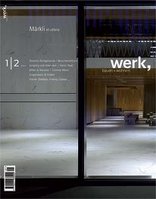Zeitschrift
werk, bauen + wohnen 1/2-07
Märkli et cetera
The selection of buildings compiled in this „et cetera“ issue is, for the most part, based on topicality and - naturally enough -reflects our interests and our striving for quality. Each building represents a remarkable contribution to contemporary architecture and is therefore awarded individual recognition in the form of a critical assessment. But all these buildings have in common the fact that they communicate in an intensive way. They are connected in a variety of ways – and with an unusual degree of closeness – with their surroundings, with the circumstances under which they were created, with history and with us as viewers, users or architects. Architecture as a form of communication, which has so often been pronounced dead, once more demonstrates its vitality. In the process it is made clear how accustomed we are to simple and probably rather banal architectural ways of making references, such as the use of contrast, for example. We are familiar with all those buildings that celebrate „being different“, whether it be as a „solitaire“ moulded by the hand of the artist-architect - no matter how „subtly inserted in its context“ it may be – or in the form of historicisms that seek to escape this world and to deny their own time and history. The ways in which the buildings introduced in this issue express themselves as part of their environment and engage with it are more complex, varied and, at times, perhaps also more difficult. In their old person's home Miller & Maranta strengthen the aspect of „public“ in the brief by allowing it to influence the building as a whole and thus creating a close link (that is both spatial and functional) with urban space. In a similar way Heinz Tesar has expanded the programme „bank“ in Innsbruck to create a „Stadtforum“ (City Forum). He makes parts of the building public in a way that goes further than the measures usually taken and connects its interior directly and by means of visual relationships with the spaces of the surroundings, both near and far away. His forms may be more personally influenced and, so to speak, more Baroque that those that Peter Märkli has created for his Novartis Building, but in both projects architecture communicates primarily by means of the disposition and dramaturgy of spaces and volumes, that is to say by using elementary architectural means „on this side of the symbolic“. In contrast the „Lokomotive“ housing development by Knapkiewicz & Fickert and the Graubündner Kantonalbank by Dieter Jüngling und Andreas Hagmann are more narrative in that they awaken memories of known and familiar images and suggest stories of a matching kind. Unlike the traditional „architecture parlante“ however, these buildings do not speak about their function and their meaning but primarily about their location and its history. The success of architecture of this type may be measured – at least to some extent – by how successfully it incorporates the diverse aspects of function, space, effect and meaning in a complex whole. Naturally, this synthesis cannot always be made as elegantly as in Corinna Menn's viewing tower in Flims, which rises with a simple and memorable gesture above the Rhine Gorge. The editors
Thema
Astrid Staufer
Totale Das Gebäude Fabrikstrasse 6 im Basler Novartis Campus von Peter Märkli
Otto Kapfinger
Gebaute Partitur der Stadt-Natur BTV-Stadtforum Innsbruck von Heinz Tesar
Martin Tschanz
Stadthaus, Business-Welt, Gewächshaus Die Erweiterung der Graubündner Kantonalbank in Chur von Dieter Jüngling und Andreas Hagmann
Christian Penzel
Urbanes Wohnen im Alter Seniorenresidenz Spirgarten in Zürich-Altstetten von Miller & Maranta
Philipp Esch
St. Petersburg – Winterthur – Neapel Wohnüberbauung ‹Lokomotive› in Winterthur von Knapkiewicz & Fickert Architekten, Zürich
Christoph Baumberger
Segler über der Schlucht Aussichtsplattform in Conn bei Flims von Corinna Menn
Forum
Kolumne: Kai Strittmatter
Wettbewerb: Zwei Studienaufträge zum Stadtraum HB Zürich
EFH: Haus in Epalinges VD von Jean-Paul Jaccaud mit Du Pasquier, Pidoux, De Marignac Architectes
Anmerkung werk-material: Das werk-Material folgt aktuellen Entwicklungen
Kommentar werk-material: Pädagogische Hochschule Schwyz in Goldau von Meletta Strebel Zangger
Kommentar werk-material: Schulhaus Steinmürli in Dietikon ZH von Enzmann Fischer Architekten
Kommentar werk-material: Le Corbusiers Kirche in Firminy
bauen + rechten: Haftung für Kostenüberschreitungen
Innenarchitektur: Drei Dauerausstellungen von Schweizer Naturmuseen
Ausstellung: Jean Prouvé im Vitra Design Museum
Ausstellung: 30 japanischen Architekturbüros der jüngeren Generation
Bücher: Atlas of Shrinking Cities
Ausstellungen | Veranstaltungen | Wettbewerbe
Neuerscheinungen | Produkte
werk-Material
Meletta Strebel Zangger, Zürich und Luzern: Pädagogische Hochschule Zentralschweiz Schwyz, Goldau SZ
Enzmann + Fischer AG Architekt/innen, Zürich: Erweiterung Primarschulhaus Steinmürli Dietikon, ZH
Thema
Astrid Staufer
Totale Das Gebäude Fabrikstrasse 6 im Basler Novartis Campus von Peter Märkli
Otto Kapfinger
Gebaute Partitur der Stadt-Natur BTV-Stadtforum Innsbruck von Heinz Tesar
Martin Tschanz
Stadthaus, Business-Welt, Gewächshaus Die Erweiterung der Graubündner Kantonalbank in Chur von Dieter Jüngling und Andreas Hagmann
Christian Penzel
Urbanes Wohnen im Alter Seniorenresidenz Spirgarten in Zürich-Altstetten von Miller & Maranta
Philipp Esch
St. Petersburg – Winterthur – Neapel Wohnüberbauung ‹Lokomotive› in Winterthur von Knapkiewicz & Fickert Architekten, Zürich
Christoph Baumberger
Segler über der Schlucht Aussichtsplattform in Conn bei Flims von Corinna Menn
Forum
Kolumne: Kai Strittmatter
Wettbewerb: Zwei Studienaufträge zum Stadtraum HB Zürich
EFH: Haus in Epalinges VD von Jean-Paul Jaccaud mit Du Pasquier, Pidoux, De Marignac Architectes
Anmerkung werk-material: Das werk-Material folgt aktuellen Entwicklungen
Kommentar werk-material: Pädagogische Hochschule Schwyz in Goldau von Meletta Strebel Zangger
Kommentar werk-material: Schulhaus Steinmürli in Dietikon ZH von Enzmann Fischer Architekten
Kommentar werk-material: Le Corbusiers Kirche in Firminy
bauen + rechten: Haftung für Kostenüberschreitungen
Innenarchitektur: Drei Dauerausstellungen von Schweizer Naturmuseen
Ausstellung: Jean Prouvé im Vitra Design Museum
Ausstellung: 30 japanischen Architekturbüros der jüngeren Generation
Bücher: Atlas of Shrinking Cities
Ausstellungen | Veranstaltungen | Wettbewerbe
Neuerscheinungen | Produkte
werk-Material
Meletta Strebel Zangger, Zürich und Luzern: Pädagogische Hochschule Zentralschweiz Schwyz, Goldau SZ
Enzmann + Fischer AG Architekt/innen, Zürich: Erweiterung Primarschulhaus Steinmürli Dietikon, ZH
Weiterführende Links:
Verlag Werk AG







